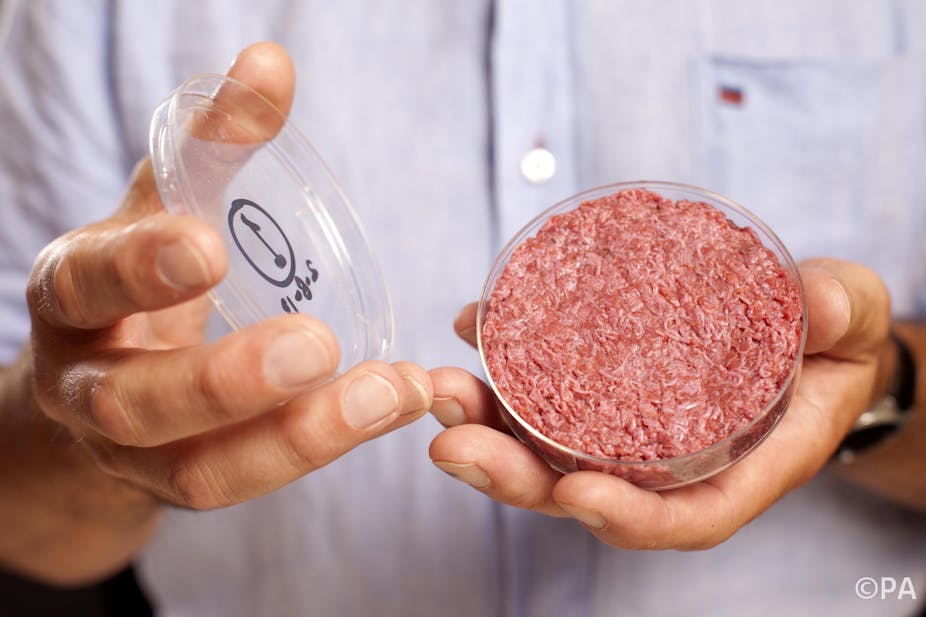The launch of the lab-bred “meat” in London was a masterly act of timing, theatre, and media management. But now that rabbit is out of the hat, there are questions that need to be asked, and answers that policy makers need to find.
1. Is it meat?
Surely this will test the limits of trades description. Meat is usually defined as coming from an animal with flesh and blood. This comes from antibiotic sources, has no fat and is grown on serum from the blood of unborn cows gathered from slaughterhouses, we gather.
UK law states: food “shall be the nature, quality and substance demanded”. It’ll surely require quite a cultural shift to accept this as meat. Much propaganda is needed before this satisfies culture and convention.
2. Will it be approved?
Policy makers are increasingly worried about a coming protein gap. Where will these proteins come from? Plants or animals are the options, but animals are resource-expensive. Most policy-makers agree the need to re-emphasise plants as our primary protein sources.
Meat eating on the scale the West (especially North American) has promulgated might well go down as a passing moment in the 10,000 year human agri-culinary history. Meat on feast days used to be a general cultural rule. Now every day is a feast day.
3. Is it new?
Mark Post, the University of Maastricht scientist, may be the first to claim it, but this technology has been some time in preparation. The first lab-based meat - from goldfish - was cultured in the early 2000s. And there was even a public demonstration in 2011.
The concept of lab-bred burgers has been flagged by journalists for some time. The capacity for muscle to work itself outside the body was proven back in 1912 by a Nobel Prizewinner, no less, who kept it “alive” for 20 years.
4. Does it resolve animal welfare concerns?
Some welfarists welcomed it. Others, rightly in my view, sense that this won’t stop conventional meat sources continuing to proliferate, not least since this burger indirectly required slaughtered animals. That seems to herald not an end to ethical concerns, but the arrival of a new level of ethical complexity.
5. Why is this stuff even being developed?
It’s technically sophisticated, comes with a “wow” factor, but also requires huge investment. For a single burger, the reputed €250,000 is steep. It helps to have a billionaire backer - Google’s Sergey Brin - but will this ever graduate to commercial production? This cannot help us with the food crisis we face now - the lab-bred burger is a decade away at least. It also maintains rather than refines the current agri/cultural obsession with meat.
6. What are the health implications?
Those who tasted the lab-burger last week noted the lack of fat. That might conceivably appeal to processors wanting to market low-fat foods, but not for long I suspect. Why produce more meat in the first place? For health and environmental reasons, the West’s love affair needs to wane, and most public health analysts agree. We need investment and ideas in how to lower consumption, not fan its barbecued embers with technical fixes.
More worrying is the lab-burger technology’s reliance on antibiotics. Anti-microbial resistance is already a running sore in public health - it would be foolish to institutionalise mock meat around huge antibiotic use.
7. Was it all hyperbole and marketing?
Launching when the West’s politicians are mostly away on holiday guaranteed front page stories. Of course in some respects this one burger did warrant the news - like Dolly the Sheep, it’s a milestone on the winding road of our technical control over food. I wouldn’t be surprised if the innovation eventually is used elsewhere, in surgery or medical research perhaps. This is a solution looking for a problem, not a need or want being resolved.
8. Who will buy and sell it?
This is where social dynamics come into play - this will not be for haute cuisine use. It lacks cachet, it’s not the real thing. I don’t see this being trickled down through the social classes. But the alternative, that this is proposed for the developing world, is preposterous. Cultures raised on real food wouldn’t touch it with a barge-pole, let alone a knife and fork. There are already many fill-ins for processed foods - Quorn, tofu, TVP (textured vegetable protein), or cereals. We should be aiming for better real food, not bizarre ersatz versions. And will it pass the laugh test? Who will risk their reputation on selling this? Retailers and caterers are so far noticeably silent.
All in all, it would be wrong to dismiss the lab burger as amusing sci-fi entertainment, however tempting. This deserves proper debate. Equally, it would be illiterate to see it as salvation for the world’s unfolding food crisis - it is likely to be irrelevant for current, let alone future food needs. Considerable scepticism is required - were it not already an ingredient added excessively to processed foods, increasing the health burden of modern diets, I’d say we should take this with a pinch of salt.

